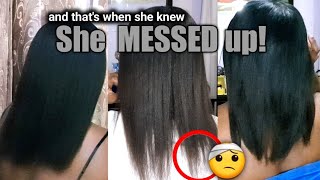The Search and Destroy Method

Have you ever heard the saying ‘ If it aint broke, don’t fix it” well that is my personal approach to trimming my hair.
That’s why I am an avid supporter of the search and destroy method for natural hair, and I have found that for those women who have relaxed hair, the search and destroy method has been very beneficial to them as well.
So what is the search and destroy method you ask? Well in the interest of typing less we will call it the S&D for short and it is basically searching your hair in a methodological fashion looking for split or damaged ends and cutting the offending strands off.
The best way to understand it is by comparing it to a traditional trim. A regular trim takes away a lot of length at the bottom of your longest layers often cutting perfectly good hair strands and missing some of the shorter strands that might be damaged too.
When you S&D, you trim only the individual strands that are damaged and ending up with what one might consider a more thorough and effective trim.
Now before you run off and buy an expensive pear of hair shears, please understand that the search and destroy method is great as maintenance in between but not a replacement for a regular trim.
So if you know that your hair is significantly damaged aka mini chop worthy, then go ahead and get a proper trim ensuring that your hair is in great health first.
Some women do a mini chop, two inches or more at least once a year for general hair health and shape maintenance and practice S&D throughout the year but however you decide to do it, just make sure those ends stay in great shape.
The key to a successful S&D session is organization, your hair should be separated into workable sections so that you can ensure that your are getting every portion of your hair.
Below is one of our favorite relaxed hair gurus PrettyWitty77 who demonstrates how she does the S&D method on her hip length relaxed hair. But before you watch the video we do not mind outlining a few of steps here.
1. If you are natural, stretch your hair first with or without heat to make it easier to trim.
2. Separate your dry hair into four to six workable sections.
3. Detangle the section getting rid of any snarls or tangles.
4. Slide your hand down the length of your hair until you get to the ends saving at least an inch so you can start searching for splits or damage.
5. Using a very sharp pair of scissors snip right above any split end or single strand knot.
6. Comb through the section a couple more times to ensure that you have not missed anything.
7. Move to the next section and repeat.
OK now you can watch the video!
Give this simple method a whirl, the cool part about it is you do not need any special skill and you will end up retaining more length than keeping your hair to a regular trimming schedule that it probably does not need!




